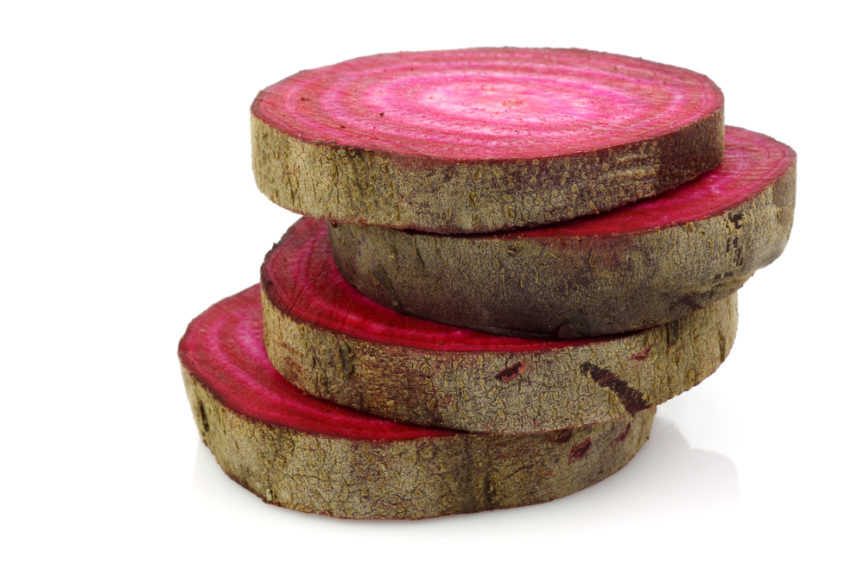A big, fat, red British root, beetroot has one of the highest sugar contents of any vegetable. Up to 10% of beetroot is sugar, but it is released slowly into the body rather than the sudden rush that results from eating chocolate. Beetroot contains betaine, a substance that relaxes the mind and is used in other forms to treat depression. It also contains trytophan which is also found in chocolate and contributes to a sense of well being.
Beetroot is virtually fat free and low in calories. Although it has a ‘medium’ GI (Glycaemic Index) of 64, It has an extremely low GL (Glycaemic Load) of 2.9 which means it’s converted into sugars very slowly and therefore helps to keep blood sugar levels stable.
They come in all shapes and sizes but the most common is round and deep red in colour. Other varieties are yellow, white, and even candy-striped (with red and white concentric circles). The humble beetroot is sweet, earthy and tender to eat and related to the turnip, swede and sugar beet.
Beetroot continued to grow in popularity in Victorian times, when its dramatic colour brightened up salads and soups. It was also used as a sweet ingredient in cakes and puddings.
Perfect partners
There are many herbs and spices that go well with beetroot including balsamic vinegar; bay leaves; citrus; chives; garlic; horseradish; mustard (recommended by the Roman writer, Pliny!); peppercorns and thyme.
Since the 16th century, beet juice has been used as a natural red dye. To cure the inevitable ‘pink fingers’, rub with lemon juice and salt before washing with soap and water.
Fun facts!
- Beetroot can be made into a wine that tastes similar to port.
- You can use the juice to measure acidity. When added to an acidic solution, it turns pink, but when it is added to an alkali it turns yellow.
- Not only is beetroot great for boosting stamina and making muscles work harder, it also contains potassium, magnesium and iron as well as vitamins A, B6 and C, and folic acid. Beets also contain carbohydrates, protein, powerful antioxidants and soluble fibre. What’s more, just three baby beetroot equal one of your recommended five portions of fruit and vegetables a day.
- The high content of nitrates in beetroot produce a gas called nitric oxide in the blood which widens blood vessels and lowers blood pressure. A daily dose of 250ml of beetroot juice or 1 to 2 cooked beetroot (approx. 100g) can help dramatically reduce blood pressure and its associated risks.
- Betacyanin, the pigment that gives beetroot its colour, is also an antioxidant. Antioxidants are believed to help reduce the oxidation of LDL cholesterol, in turn protecting artery walls and reducing the risk of heart disease and stroke.
- Beetroot contains folic acid which is essential for normal tissue growth.Beetroot also contains iron, so it’s particularly great for ladies during pregnancy. Beetroot’s iron content means it’s good for those with anaemia and fatigue.
- Beetroot contains the mineral silica. This helps the body to utilise calcium, which is important for musculo-skeletal health and reducing the risk of osteoporosis.
- Make the most of beetroot with Warm Steak Beetroot Sandwich with Honey Mustard Dressing.
Resource: www.livinghistory.co.uk
News items and features like this appear in the Desang Diabetes Magazine, our free-to-receive digital journal (see below). We cover diabetes news, diabetes management equipment (diabetes ‘kit’ such as insulin pumps and continuous glucose monitoring equipment) and news about food suitable for a diabetic diet including a regular Making Carbs Count column. We just need your email address to subscribe you (it’s free, and you can easily unsubscribe should you wish to).

